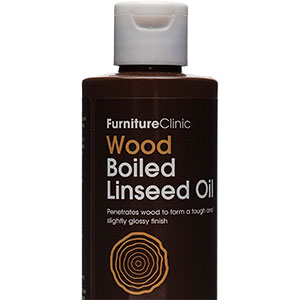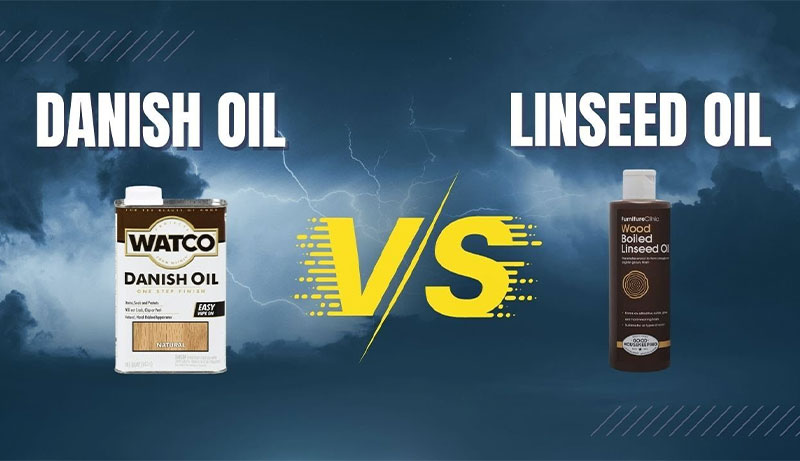As an affiliate, we may earn a commission from qualifying purchases. We get commissions for purchases made through links on this website from Amazon and other third parties.
When you are unsure about which oil to use for your upcoming furniture project, the conflict between danish oil and linseed oil is unavoidable. It can be difficult and time-consuming to pick one.
The intricacy is increased by the fact that the two wood oils share a lot of similarities. But each of these oils has special qualities of its own.
You may therefore make an informed choice by learning about their applications, advantages and disadvantages, application techniques, drying times, and finishes.
We conducted the research and gathered all the data in this post for your convenience.
Why don’t we start now?
| Image | Product Name | Editor's Rating | Price |
|---|---|---|---|
 | Danish Oil | Check Price | |
 | Linseed Oil | Check Price |
What Is Danish Oil?
One of the most widely used wood finishes is Danish oil. It adds a beautiful and protective coating to wood. Additionally, Danish oil can give the wood a long-lasting, deeply penetrating, and economical finish.
The wood will therefore be able to withstand any environmental harm, including water damage. Danish oil is a concoction of varnish, thinner, and oil.
These components give the wood a smooth gloss, enhancing its inherent beauty. Danish oil can also be used as a primary wood primer before painting.
What Is Linseed Oil?
Linseed oil has been used as a wood finish and food ingredient for hundreds of years (in its edible form). Given that it is created from dried, matured flaxseeds, linseed oil is also referred to as flaxseed oil.
Sometimes, after crushing the flax seeds, solvents are used to extract the oil. Linseed oil, also referred to as contemporary wood oil, has grown in acceptance in recent years. It also goes by the name “drying oil” because of its capacity to polymerize.
This characteristic enables producers to mix linseed oil with other oils and solvents to make various mixes. In addition to being used as a varnish, resin impregnator, and putty hardener, linseed oil is also used to finish wood.
Danish oil vs linseed oil Front to Front
When comparing the advantages and disadvantages of the two oils, Danish oil unquestionably triumphs in the debate over linseed oil.
Danish oil wins because it dries quickly, can be used on both indoor and outdoor wood, is hard to cover, and doesn’t allow mould to grow. Danish oil excels due to its defence against UV deterioration.
Despite this, linseed oil is still beneficial. On the other hand, it might be ideal for indoor wood projects that don’t get much moisture exposure.
Due to its lack of chemicals, raw linseed oil may also be the finishing that is the most food-safe. However, keep in mind that boiled linseed oil shouldn’t be used since it includes highly harmful components.
Danish oil vs. linseed oil: Use
Danish oil
Typically, Danish oil needs three coats. It is typically applied using two methods.
The wet on wet technique, commonly referred to as the single day technique, calls for applying each application in one sitting. Between coats, let the wood an hour to absorb enough oil to form a protective natural layer. After 48 hours, the wood is ready for use.
Applying one coat of Danish oil per day is the one coat a day method. With a cloth, remove any extra oil that is left and allow the area to air dry. For three days, do this again. with wire wool or abrasive paper, you can eliminate dust or nibs with this technique in between coats.
linseed oil
Applying linseed oil to wood that has already been painted, varnished, or waxed will prevent it from penetrating.
You should sand and dust the wood’s surface to ensure optimum penetration. Usually, three coats separated by 12 to 24 hours are sufficient.
Lightly hand polishing the surface after it has been burnt is a great method to improve the satin quality of the final layer.
In any event, here is a useful method for removing linseed from wood if you are dissatisfied with the results.
Danish oil vs. linseed oil: visual differences
Danish oil
Danish oil adds more sheen and glossiness, enhancing the natural beauty of wood. The darker shade also gives the wood a distinctive appearance.
After wiping, the oily residue that was left behind may give the wood a smooth gloss. Additionally, as seen on jewellery boxes and picture frames, this oil can give you a gentle sheen or rustic finish.
linseed oil
The golden colour of linseed oil eventually turns amber. The oil will not only protect the wood but also slightly colour it, bringing out its inherent grain.
Teak oil, a linseed oil-based product with additives, can be used to enhance the wood’s colour and grain.
Decision: This round is won by Danish Oil.
Uses
Danish oil
Danish oil is most frequently used to exterior wood because of its strength and resistance.
Danish oil is also great for finishing the following timber surfaces.
surfaces:
- Utensils
- wood flooring
- Wood doors with a turn
- Windows Furniture
- Boards for skirting Kitchen countertops
linseed oil
The following uses for linseed oil are possible:
- as a binder for paint
- Putty Wood Finishing Gilding Linoleum Natural food and vitamins
Conclusion: Once more, Danish oil comes out on top.
Protection Against Elements
Danish oil
Due to the industrial process’ use of polymerization, Danish oil has exceptional water resistance. Additionally, it could keep grime off of your wood furniture. Danish oil is generally resistant to food, alcohol, and water.
linseed oil
The materials and metals can withstand corrosion and are shielded from water damage thanks to the protective qualities of linseed oil.
Conclusion: Danish Oil provides greater resistance to the elements than linseed.
Durability
Danish oil
The transparent finish of Danish oil gives wood projects long-lasting protection and attractiveness. Danish oil has an approximate lifespan of 10 to 20 years.
linseed oil
As long as you are aware of its limitations, linseed oil makes a good standalone finish. Linseed oil paint has a lifespan of 50 to 100 years with very little upkeep.
Conclusion: Linseed Oil triumphs in this situation.
Components
Danish oil
To enhance longevity and convenience of use, Danish oil is frequently blended with linseed oil, mineral oil, synthetic resins, Tung oil, and varnish. It is well recognised that Rustin’s Danish oil is the “original” recipe.
linseed oil
The drying process is accelerated by petroleum-based additives such naphtha, mineral spirits, and di-propylene glycol monomethyl. Boiling linseed oil contains a number of metals, including cobalt and manganese.
Danish oil versus boiled linseed oil: Penetration
Danish oil
Excellent resistance to water and other liquids is provided by Danish oil. For woodwork, it serves as a waterproofing covering. Water molecules cannot penetrate the wood due to polymerization.
linseed oil
Linseed oil provides comparable protection against water seepage into the wood. Linseed oil deeply permeates the wood, shielding it from the inside out.
Conclusion: Danish oil is a clear winner in this comparison because it can be used on both interior and exterior wood.
Drying Period
Danish oil
Depending on the temperature and humidity, Danish oil dries in between four and six hours. The quick drying period results in a smooth, non-tacky surface.
linseed oil
Depending on the location and the thickness of the application, linseed oil might take anywhere from two to ten weeks to completely dry.
In conclusion, Danish oil triumphs once more.
Finish
Danish oil
On decorative tables, clocks, and picture frames, Danish oil provides a supple, rustic feel. Danish oil also adds gloss and a smooth sheen to things. Danish oil will colour the wood as it matures.
linseed oil
Linseed oil highlights the wood’s natural colour. This oil also imparts a dry feel to the wood, which conceals uneven or spotty surfaces.
Conclusion: This round is won by Danish oil.
Boiling linseed oil versus Danish oil: Which is more toxic?
Danish oil
Danish oil is not poisonous when used properly. The oil becomes wood safe when it has completely dried and developed a tough, long-lasting layer on the surface.
linseed oil
Boiling linseed oil is created by adding chemicals (petroleum-based or dry metals) that make the oil poisonous to humans. So, hold off on using the utensils for food until the coatings have had time to cure completely.
Conclusion: Since both of these oils are secure after fully drying, there is a tie.
Decision on Danish Oil vs. Linseed Oil
Our Danish Oil vs. Linseed Oil comparison shows that Danish oil is superior to linseed oil in terms of finish, durability, and drying time. Each, though, has benefits and applications.
Check out our guide to the best oil for wood if you don’t feel comfortable using any of these treatments.
